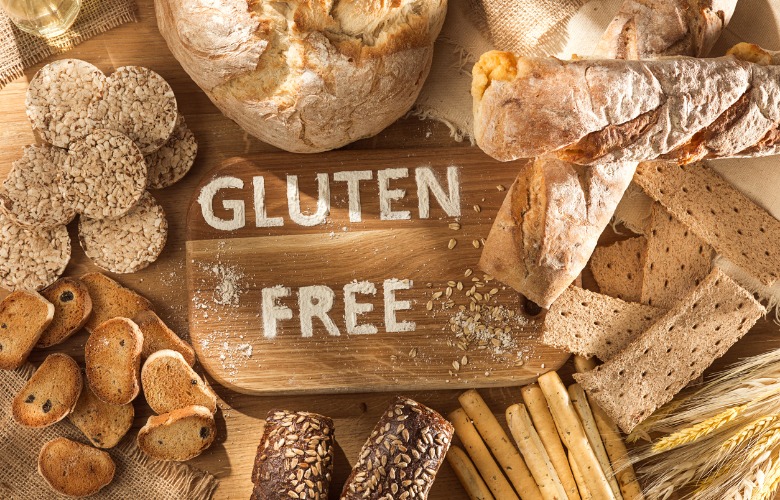Celiac Disease: Its Causes, Symptoms, and Diet
Posted by Jemile Nesimi Hobson, B.A. on Oct 12, 2024
If you’ve heard of the gluten-free diet, then you know that it’s become quite popular these days. Celebrities, fitness gurus, and health-conscious people everywhere have begun eliminating gluten from their everyday diets. But what about those who have celiac disease, the condition that requires them to abstain from eating foods that contain gluten. How can people with celiac disease keep themselves healthy in a world full of wheat?
What is Celiac Disease?
In the past, celiac disease wasn’t easy to diagnose. Today, a simple blood test called a ‘celiac panel’ can tell your doctor if your body is reacting to gluten, a protein found in wheat, barley, and rye grain. Celiac disease is an autoimmune condition characterized by inflammation. When someone with celiac disease ingests gluten, an immune response is triggered in their small intestine, and over time, the lining of the small intestine becomes damaged and unable to absorb essential nutrients into the bloodstream (malabsorption). This malabsorption can manifest in many ways. Untreated, symptoms that can develop include anemia, diarrhea, fatigue, bloating, gas, nausea, vomiting, abdominal pain, constipation, and painful, itchy skin rashes known as dermatitis herpetiformis. Other symptoms include mouth ulcers, joint pain, headaches, and malnutrition.
Untreated celiac disease can also lead to serious complications such as multiple sclerosis, osteoporosis, cancer, neuropathy, infertility, and coronary artery disease. For people with celiac disease, adhering to a strict gluten-free diet is crucial. Avoiding gluten is currently the only treatment for celiac disease, and the only way that affected individuals can find relief from symptoms.
What Causes Celiac Disease?
While the precise cause of celiac disease is not known, there are several risk factors that may contribute to developing this condition. Celiac disease appears more commonly in people who have the following risk factors: type 1 diabetes, Addison’s disease, autoimmune thyroid disease, Turner syndrome or Down syndrome, microscopic colitis, or a biological family member who has dermatitis herpetiformis or celiac disease.
Celiac disease is hereditary, meaning that it runs in families. If someone has a parent, child or sibling with celiac, they have a 1-in-10 chance of developing it. It is important for anyone who has a close relative with celiac to be tested to prevent serious complications from developing.

What to Eat When You Have Celiac Disease
When someone gets diagnosed with celiac, it can be overwhelming. Figuring out what to eat and what not to eat can be challenging. Not long ago, it was hard to find foods labeled “gluten-free”. Today, in addition to all the naturally gluten-free foods that are easily found in any supermarket, there are seemingly endless gluten-free products to choose from, with some supermarkets having entire aisles dedicated to these products. Many manufacturers who cater to consumers on a gluten-free diet will pursue gluten-free certification for their products. This means that consumers can trust that the food they are eating adheres to FDA regulations on what can be labeled “gluten-free”. Currently, food must contain less than 20 parts per million (ppm) of gluten to get the gluten-free seal of approval.
What Can I Eat? What Foods Should Be Avoided?
There are many foods that are safe to eat for people with celiac disease. Meat, fish, cheese, butter, milk, eggs, potatoes, rice, rice noodles, corn, beans, lentils, quinoa, buckwheat, amaranth, oat (oats are naturally gluten-free but can become contaminated with gluten in processing facilities, so only certified gluten-free oats are truly safe) and fruits and vegetables are all safe to include in a gluten-free diet. Pasta, bread, crackers, cookies, cakes, pies, gravies, and sauces should all be avoided unless they are labeled “GF” or “Gluten-Free”.
How to Keep from Getting Sick
Even a small bit of gluten is enough to make someone with celiac disease very sick. A tiny crumb of gluten can start the autoimmune response, even when no symptoms are present. In addition to avoiding foods that contain gluten, people with celiac disease must avoid cross-contact with gluten. Cross-contact happens when food that is gluten-free is exposed to gluten, causing the food to become unsafe.
If a kitchen is not 100 percent dedicated gluten-free, there is a chance for cross-contact to occur. For this reason, it can be difficult for people with celiac disease to eat safely when they are dining out.
Some Ways to Avoid Cross-Contact with Gluten
Gluten can lurk in places that are unexpected. Talk with family members about how to help someone with celiac to avoid becoming sick. If using a shared kitchen, and it is not possible to keep the kitchen 100 percent gluten-free, it is important to talk to everyone about how to help avoid cross-contact.
Label things. Write “GF” on jars and containers so that utensils that have been exposed to gluten won’t find their way in. If someone dips a knife into a jar of nut butter and then spreads it onto regular, gluten-containing bread, and then puts that knife back into the jar, it is no longer safe for someone with celiac to use. The same goes for butter, mayonnaise, anything that is in a container. Buy squeeze bottles for condiments to avoid this.
Keep a separate toaster. Toasting gluten-free bread in the same toaster where regular bread is toasted is not safe and the risk of cross-contact is very high.
Buy separate sponges and utensils and again, label everything. It may seem like a lot, but for someone with celiac disease, adhering to these precautions will help keep them healthy and safe from a serious illness.
Questions to Ask When Dining Out
Dining out can be especially challenging for those with celiac disease. It is important to know what questions to ask, and when to ask them so that the risk of becoming sick from gluten is minimized. Research is key.
Calling a restaurant ahead of visiting is recommended. Ask if the restaurant has a gluten-free menu, and what menu items can be made gluten-free. Most restaurants consider “no gluten” requests to be a food allergy, and staff is usually trained to accommodate food allergies as opposed to autoimmune diseases.
These days, most restaurants know what gluten is, and many will make accommodations for the gluten-free guest. It’s okay to ask the server questions with the understanding that if it’s a busy time of day, servers and kitchen staff may not be able to pay as close attention to preparing food properly to keep a person with celiac disease safe. Here are some examples of questions one might ask a server:
- Is the steak marinated in soy sauce? (soy sauce usually contains wheat).
- Are there croutons on the salad?
- Are the fries cooked in the same fryer as breaded items? Is there a dedicated gluten-free fryer/toaster, etc.
- Is the gluten-free pasta cooked in a separate pot (not in the same water as regular pasta).
- Do you use the same grill for meat as you do for burgers/pancakes/etc.
- Do you use clean utensils for GF dishes?
- Does the sauce/soup/dressing contain flour? (flour is often used to thicken these items).
- Are the mashed potatoes from a mix?
- Is imitation crabmeat used? (there is often gluten-containing imitation crabmeat used in sushi).
By doing some research, asking the above questions when appropriate, and alerting servers to their condition, dining out can still be a fun part of life for those with celiac disease.

Healthy Habits
When food shopping, read labels! Reading labels when shopping is a great habit to get into when learning to shop gluten-free. Sometimes, food labels will tell you that the item contains wheat. Wheat, barley, and rye are occasionally listed by alternative names such as triticum vulgare, triticale, or spelt, secale cereal (rye), and hordeum vulgare (barley). Pay attention to allergy warnings, and if you are unsure about whether something contains gluten, don’t buy the item. Better safe than sorry!
Learn to make a few favorite dishes at home. Creating dishes you crave can be rewarding and you don’t have to worry about cross-contact!
Skip the junk food! With so many gluten-free options on the market today, and so many manufacturers offering gluten-free versions of our favorite snacks, it can be tempting to overindulge in unhealthy snacks like cookies, cakes, donuts, and chips. These processed foods are often high in fat and sugar and are most definitely not healthier! Choose snacks that are naturally gluten-free, like hummus and veggies, or salad with a protein added. Autoimmune disease can leave people feeling depleted and making these healthier choices will lead to feeling better and having more energy.











